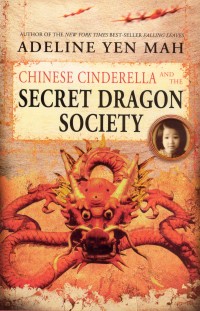| ________________
CM . . .
. Volume XI Number 17 . . . . April 29, 2005
excerpt: We are in China at this moment in history for a reason. We are here to make a difference. We are children of destiny who will unite East and West and change the world. The future belongs to us. These words are the credo of four very disadvantaged children in the Secret Dragon Society, a fictional creation in Adeline Yen Mah's inspirational novel for middle years readers. Mrs. Yen Mah draws on her memories of Shanghai during World War II to create a multi-layered adventure novel which quietly educates young readers as they follow the characters through "interesting times." The first person narrator, Yen Xian, also known as C.C. (for "Chinese Cinderella) is a 12-year-old living in Shanghai under Japanese occupation. Bullied by her stepmother, her only source of encouragement is her beloved "Big Aunt." One day, passing a park, C.C. is attracted by a team of young acrobats, directed by a woman, representing the Dragon Society Martial Arts Academy. When C.C.'s parents turn her out of the house when her aunt is away, she takes refuge in the park, where a gardener directs her to the young acrobats. At Grandma Wu's academy, martial arts training is only part of what goes on. Mrs. Wu is training her little band of mixed-race proteges in various skills in preparation for resistance. The children's ethnic backgrounds are not only realistic and possible in Shanghai at that time but also lend themselves to ethical and humanitarian discussions. Sam, for instance, came to Shanghai because his Jewish father and Chinese mother fled Hitler's Germany -- only to die at the hands of the Japanese. The motto of the society is from Sam's mother's last letter. C.C. moves in with Grandma Wu, learns kung fu and eventually becomes a member of the secret society. During the course of the novel, she and her comrades go to an island and rescue five American airmen, see a giant panda, outwit a Japanese soldier and manage to relate to him on a human level (He is young, apolitical, and was compelled to enlist.). Author Yen Mah skillfully works in much information about Chinese culture, from cuisine to the I Ching, as part of C.C.'s broad education in kung fu ("mastery of a difficult art"). The Chinese zodiac appears in detail in an appendix. The author describes the novel as a "fantasy," but this is a misnomer for, in this story, there are no dragons, magic or crystal caves. This book is rooted in reality. The rescue of the American airmen is based on an historical incident. In 1942, a U.S. bomber crashed into the sea near the island of Nan Tian, with all 10 crew members surviving. They were part of "The Doolittle Raid" on four Japanese-held cities by 16 U.S. bombers under the command of Jimmy Doolittle. The Japanese occupiers subsequently launched a savage attack upon Chinese civilians in Zhejiang Province in retaliation for the help they gave the Americans. In this novel, the children also help four captured U.S. airmen escape from prison. Yen Mah quotes from the actual letters of three of these prisoners. In her novel, the prisoners escape. In reality, they did not - all died, as explained in the appendix, "Historical Note." In distorting the fact that they all died, Yen Mah breaks a rule of historical fiction. It is one thing to have fictional characters walking hand in hand with real people of the past through historic events. But to change the outcome of an actual event is to go too far. How will family members feel when they see their war-hero relatives' actual correspondence, then read that the men did not die! In the genre of "alternative history," a form of speculative fiction, and a unique sub-category of literature, one finds novels based on the assumption that Hitler won World War II, or Roosevelt lost the election of 1940, but Mrs. Yen Mah is not writing "alternative history"; her book is the traditional, time-tested type of historical novel. Perhaps she uses the term "fantasy" to excuse this distortion. Possibly she wanted to give the prison-break section a positive outcome because her readers are young, tenderhearted, and tend to identify strongly with the fictional characters. But this is a war novel, and other terrible events are presented or alluded to, so why not this one? On the positive side, the author has grappled with big issues and hard questions and has allowed her characters to arrive at insights. An escaped prisoner, for instance, decides not to "live out of hatred," but to do something positive with his life. Religious differences are discussed, with the young people concluding that there is truth in all religions. Author Adeline Yen Mah, who left medicine in 1999 to pursue writing full time, shows her healing impulse in this ambitious work. Recommended. Ruth Olson Latta has a Master of Art's degree from Queen's University, Kingston, ON. Her most recent book is Tea With Delilah, a mystery, published by Baico Publishing, Gatineau, PQ.
To comment
on this title or this review, send mail to cm@umanitoba.ca.
Copyright © the Manitoba Library Association. Reproduction for personal
use is permitted only if this copyright notice is maintained. Any
other reproduction is prohibited without permission.
NEXT REVIEW |TABLE OF CONTENTS FOR THIS ISSUE - April 29, 2005. AUTHORS | TITLES | MEDIA REVIEWS | PROFILES | BACK ISSUES | SEARCH | CMARCHIVE | HOME |
